Created through eons of erosion and the relentless pounding of ocean waves along the shores, sea caves (or littoral caves) are true testaments to the sheer power — and persistence — of nature. From the beautiful and rugged coasts of Maine to the sunny shores of Hawaii, the United States is home to many of these natural wonders. Let’s dive in and learn a bit more about what sea caves are, how they form, and where you can find the most spectacular sea caves in the U.S.!
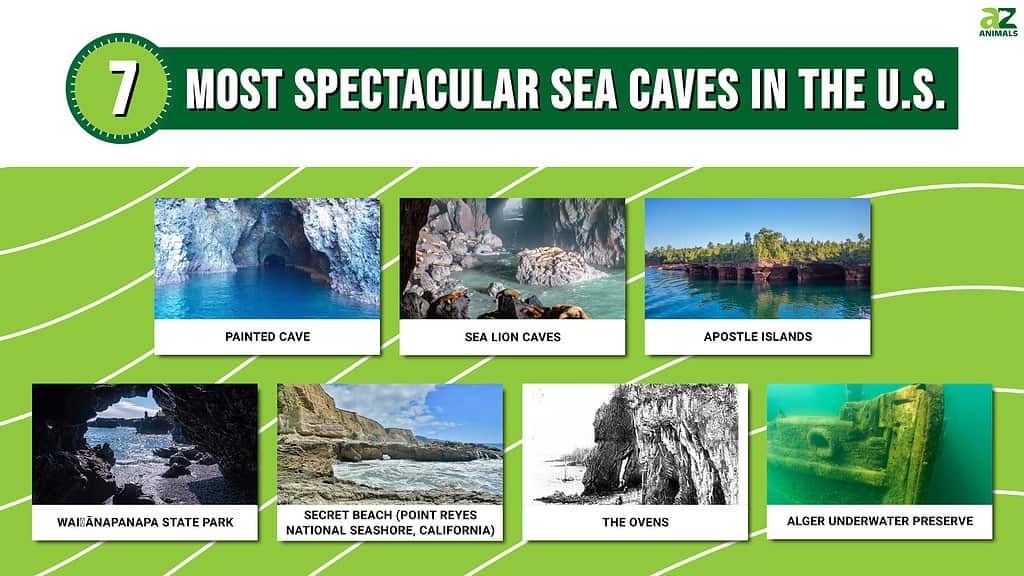
How Sea Caves Are Formed
Sea caves are created by waves that erode the bedrock along the ocean coast and lakeshores. With each crash against the bedrock, the waves etch out intricate patterns and shapes. This results in incredible formations that vary in shape, size, and even color. Sea caves can be found in almost every type of rock. They usually form where the rock is weakest, like along fractures, foliation, and bedding planes.
Over time, waves can create open sea caves on both ends, forming a natural bridge or arch. Sometimes, the arch’s roof will collapse, leaving behind a sea stack. If erosion continues, another cave may turn into an arch as well.
Not only are sea caves beautiful and fascinating, but they also serve as important habitats for many different kinds of animals. Sea lions often seek shelter from predators in sea caves, while marine fish use them to hide in the darkness. Even sea birds use sea caves for nesting and protection. They also provide homes for all kinds of unique invertebrates.
Now, let’s take a closer look at the most spectacular sea caves in the U.S.!
1. Painted Cave (Channel Islands National Park, California)
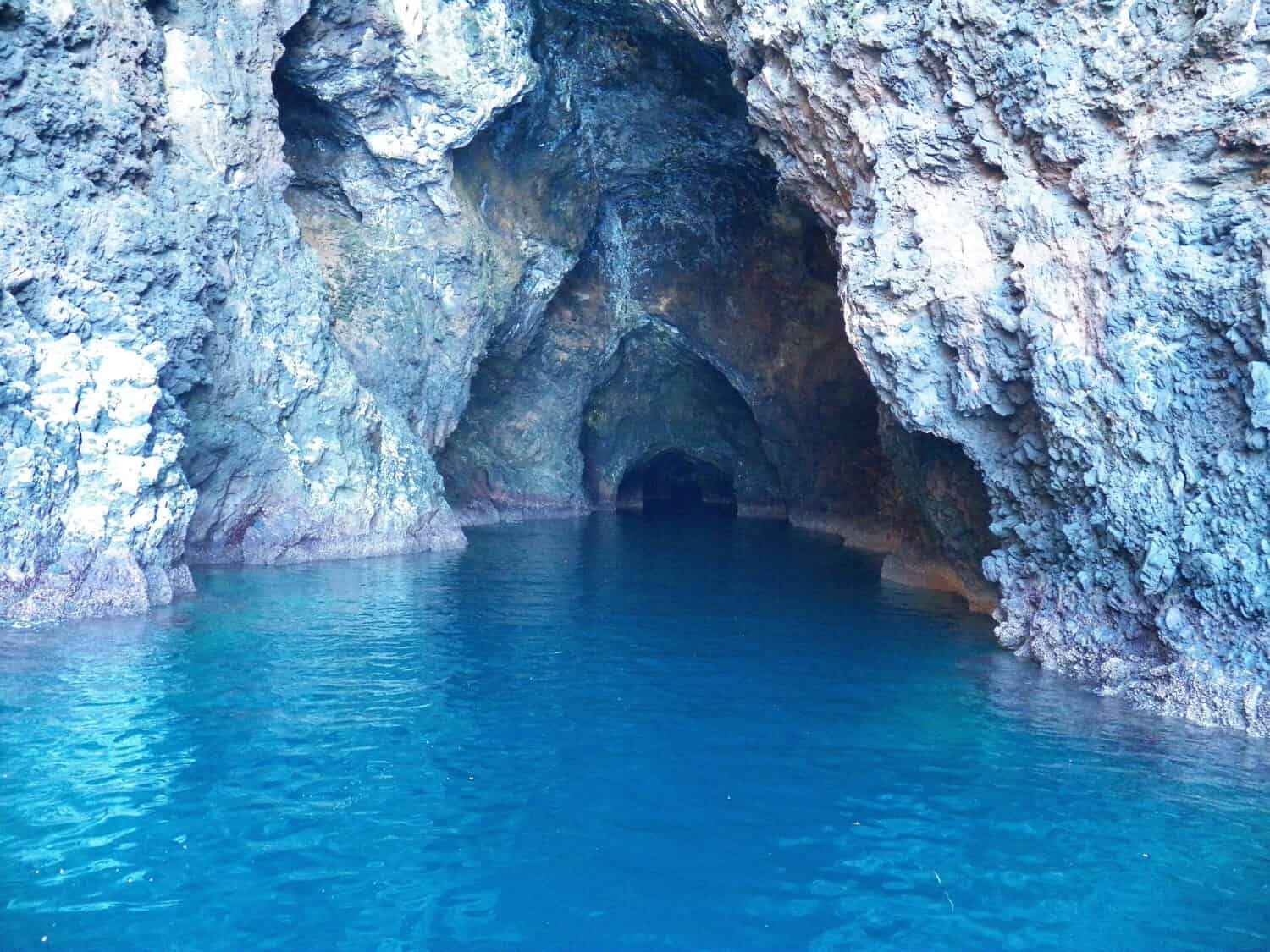
The rocks of the Painted Cave look like they have been painted with all kinds of beautiful colors.
©Kris Clifford/Shutterstock.com
Located in the Channel Islands National Park in California, Painted Cave is one of the largest sea caves in the entire world! This spectacular sea cave is longer than four football fields, measuring 1,227 feet long. The ceiling at the cave entrance is 160 feet above the water level and stretches nearly 100 feet across. However, the cave is only accessible by water. Visitors can take large tour boats to the entrance of the cave, or kayak further into the depths of the cave as well.
The Chumash word for this cave is hax̓inu mupʰ nuwaštipa, which means “big painted cave”. The cave gets its name from the unique kaleidoscope of colors that covers its rocky walls. These vibrant jewel tones come from the various types of rocks that make up the cave, as well as different types of algae and lichens there. If you come during the springtime, you’ll see a light waterfall trickling over the cave’s entrance, which makes kayaking inside even more of an adventure!
2. Sea Lion Caves (Oregon)

There are tons of steller sea lions and California sea lions in and around the Sea Lion Caves in Oregon.
©B Norris/Shutterstock.com
If you thought that Painted Cave in California was big, wait until you see the Sea Lion Caves in Oregon. These spectacular sea caves are around 25 million years old. The Sea Lion Caves are the largest sea caves in the United States. They are 1,315 feet long and nearly 12 stories high!
Originally, you could only get to the caves by sea. However, in the 1930s, a half-mile-long trail was painstakingly carved by hand into the cliff face. At its base, a wooden tower over 100 steps tall leads down to the caves’ northern entrance. Despite the difficulty and danger of constructing it, the trail and staircase provided safe access for visitors. The Sea Lion Caves opened up to the public in August 1932. Today there is also an elevator that takes visitors down into the cave as well, where they can see the cave’s colorful walls, crashing waves, and resident sea lions.
Over time, the underground section of the cave and the jagged cliffs have become the only known mainland home and winter hangout for steller sea lions (and sometimes California sea lions). The cave’s tall, arched ceiling acts as a natural resting place for sea birds. Birds like the pigeon guillemot, Brandt’s cormorant, tufted puffins, and a wide variety of gulls often rest here. And there is also a whale watching beck below the gift shop where you can spot gray whales and sometimes orcas.
3. Apostle Islands (Wisconsin)
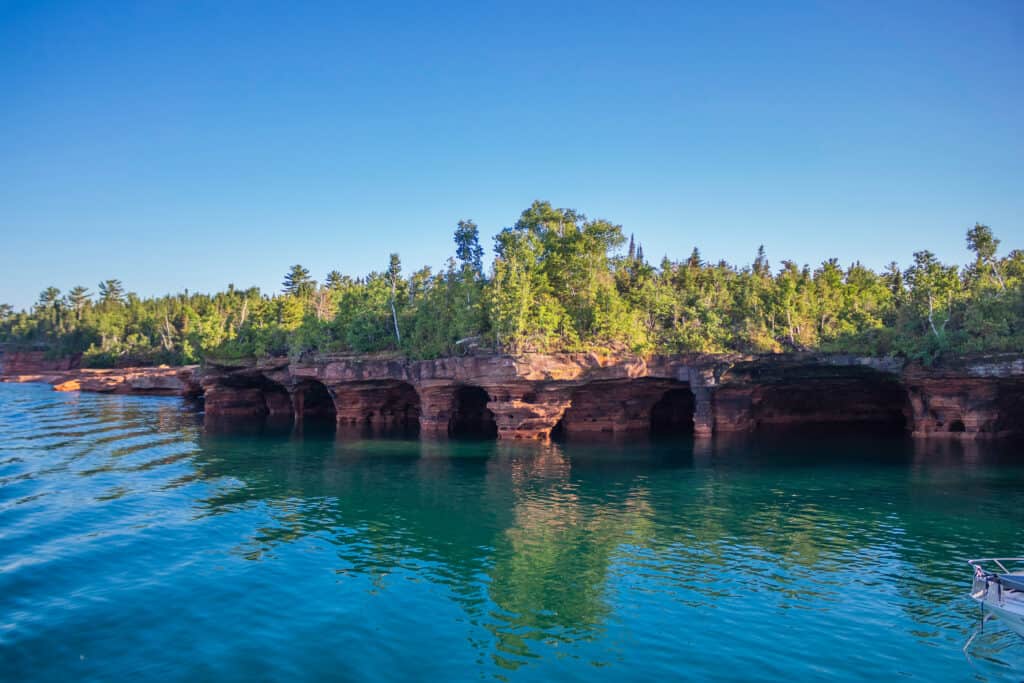
The sea caves at Apostle Islands are continually reshaping with the movement of the surrounding water.
©Gottography/Shutterstock.com
Some of the most amazing natural sites in the Great Lakes are the spectacular sea caves at the Apostle Islands National Lakeshore. The waters surrounding the Apostle Islands have carved incredible holes and tunnels into the orange sandstone cliffs. The waves left behind arches, high ceilings, and decoratively textured rocks. There are sea caves on the Devil’s Island formation, Swallow Point on Sand Island, and on the mainland near the western boundary of the Apostle Islands National Lakeshore.
Visitors can come and see these spectacular sea caves all throughout the year. Summertime is always beautiful. The red sandstone formations sharply contrast the beautiful blue water and the vibrant green forests along the cliffs. When the lake is calm, you can kayak into the deep recesses of the caves as well. During the winter, the surface of Lake Superior freezes, leaving behind frozen waterfalls and thousands of icicles. Depending on the condition of the ice, you can actually explore the frozen sea caves — now transformed into glittering ice caves filled with magical ice formations.
4. Waiʻānapanapa State Park (Hawaii)

There are several sea caves to explore along the black sand beach at Waiʻānapanapa State Park in Hawaii.
©iStock.com/ReDunnLev
If you’re planning a trip on the Road to Hana in Maui, there is one spot that you definitely don’t want to miss: Wai’anapanapa State Park. Waiʻānapanapa means “glistening water”, and these legendary sea caves are filled with plenty of it. Some say that the name refers to a very specific spot where the sunlight reflects off a stream in an unusual way. However, others believe that it refers to the crystal-clear waters found in the park’s many sea caves.
There are many spectacular sea caves to explore at Waiʻānapanapa State Park. For example, there are seaside lava tubes on Waiʻānapanapa’s black sand beach. And of course, there is the mysterious cave of Princess Popo’alaea.
According to legend, Princess Popo’alaea sought refuge in the cave as she attempted to hide from her cruel and jealous husband, Chief Ka’akea. Tragically, however, Chief Ka’akea discovered and murdered the princess. Today, the waters that flow through the cave turn a deepish red color multiple times a year. According to the locals, the water appears colored due to a particular type of algae that turns red at different points in its life cycle to honor the princess’s memory.
5. Secret Beach (Point Reyes National Seashore, California)
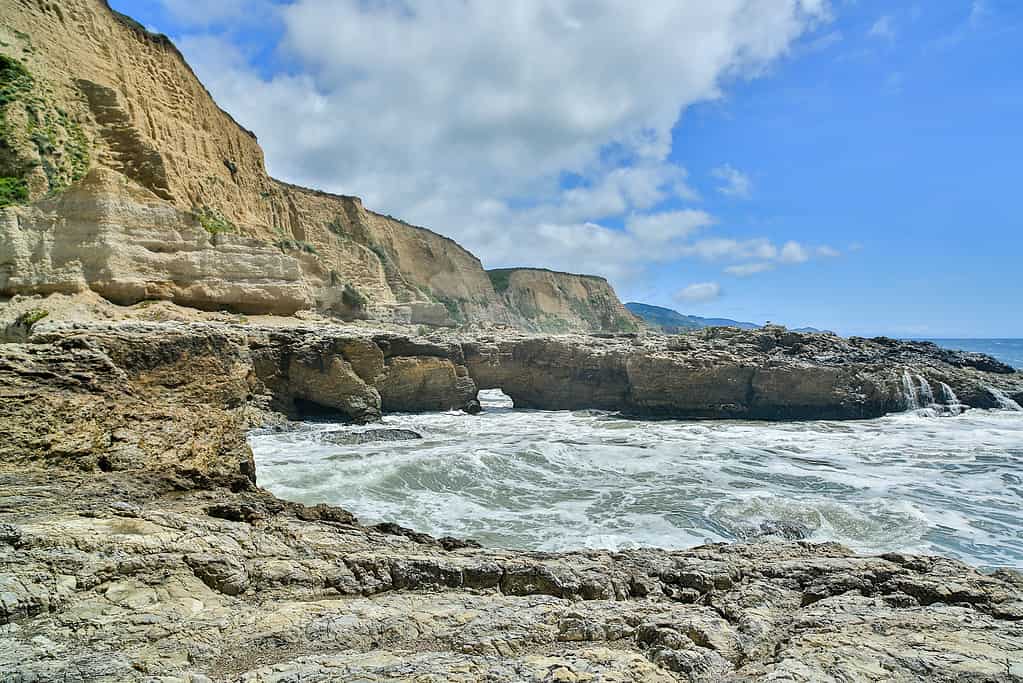
You’ll have to walk through the Sculptured Beach at Point Reyes to get to the sea caves of Secret Beach.
©iStock.com/yhelfman
The spectacular sea caves at Point Reyes National Seashore in California are a bit tricky to locate. First, you must go to Secret Beach, but like its name, the beach is hidden. In fact, it only seems to appear during very low or negative tides.
If you take a stroll along the shore of Sculptured Beach, you will eventually come upon some large rock arches. These act as natural gateways to the Secret Beach. However, there is a sharp and rocky drop near the cliff wall that you’ll need to scramble down before making the leap to the beach below. You’ll pass through the mussel-covered arches, so be careful that you don’t step on any of these precious sea creatures!
It’s a bit challenging to get to the sea caves of Secret Beach, but the adventure is filled with breathtaking scenery along the way. And once you finally make it to Secret Beach, you’ll feel as if you have been transported to a natural wonderland. There are many enchanting sea caves there, along with intriguing rock formations and tide pools filled with vibrant marine life. In addition, there’s even a natural amphitheater and a coastal waterfall!
Just make sure to plan ahead and be very careful. There is no parking at either Sculptured Beach or Secret Beach. And you’ll need to time your trip so you don’t get trapped by rising tides!
6. The Ovens (Maine)

The Ovens are part of the Bar Harbor Formation, made up of siltstone and shale.
©iStock.com/Christine_Kohler
Nestled alongside Mount Desert Island in the heart of Acadia National Park in Maine is a series of spectacular sea caves known as The Ovens. Surrounded by the crystal-clear waters of the Mount Desert Narrows, this stunning collection of sea caves looks like a bunch of naturally carved brick ovens!
The Ovens can be difficult to get to. They are only accessible by boat (the caves are open to the public, but the surrounding land is privately owned). Depending on the tide level, you might be able to walk or paddle through some of the openings. Inside the caves, you can see many dazzling and jagged rock formations, feel the cool salty air, and hear the sounds of waves crashing against their ancient walls. But be sure to plan ahead so that you can stay safe and keep an eye on the tides!
7. Alger Underwater Preserve (Michigan)
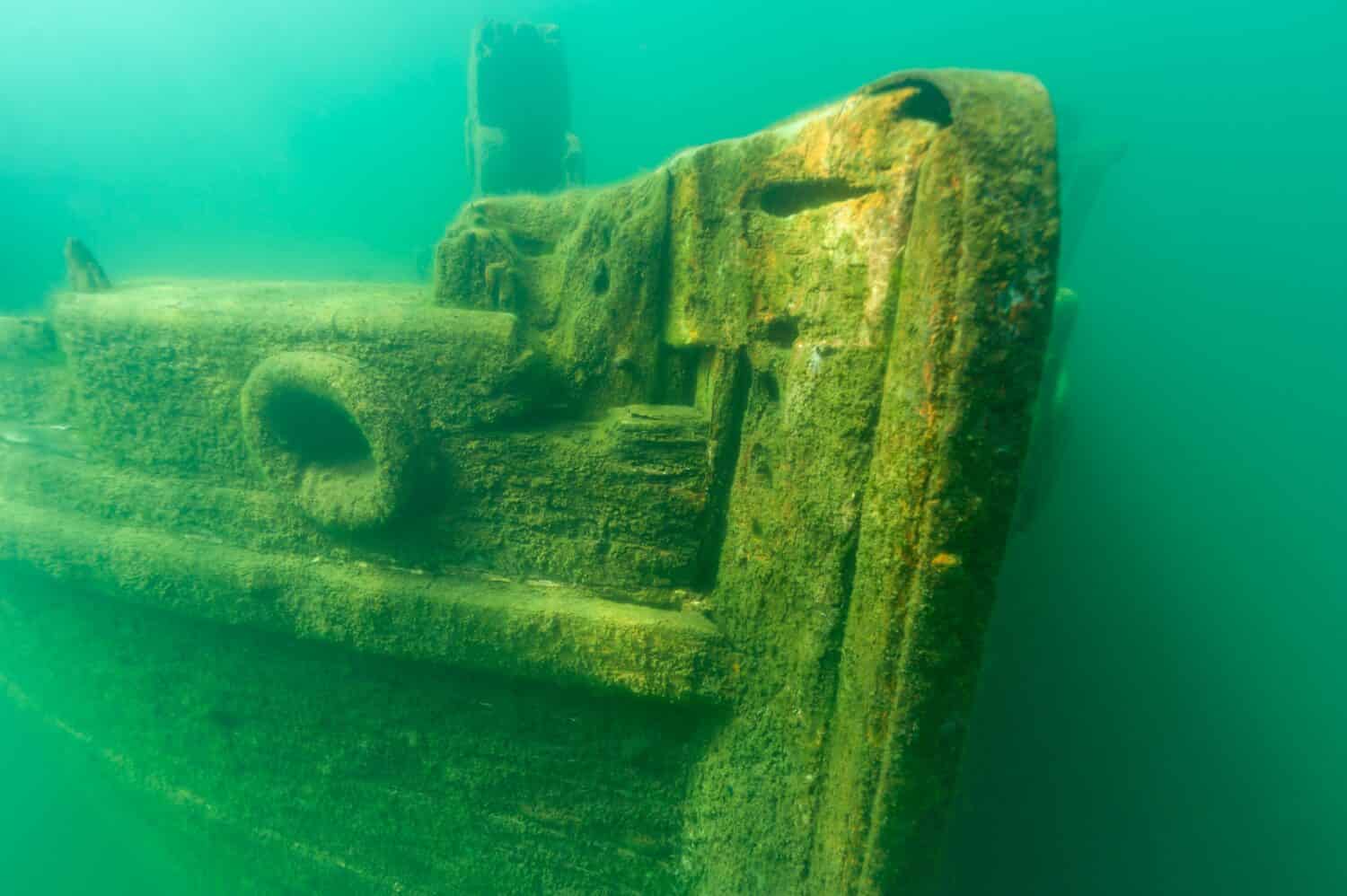
There are fascinating shipwrecks at the Alger Underwater Preserve, like The Bermuda, which sank in 1870.
©Focused Adventures/Shutterstock.com
Located just off the coast of Munising in Michigan’s Upper Peninsula, the Alger Underwater Preserve is home to some truly spectacular sea caves. These sea caves were formed as the waters of Lake Superior chipped away at the sandstone cliffs, creating a unique underwater landscape. The water of these caves is rather shallow — it’s only 10 to 20 feet deep! It is crystal clear as well, which makes the caves a perfect spot for snorkeling.
After you have explored the stunning sea caves of the Alger Underwater Preserve, you can change into your hiking boots and hit the trails at the Pictured Rocks National Lakeshore. Or you can explore the five beautiful waterfalls in the Munising area. In addition, there is a very unique glass-bottom boat tour that gives you the chance to see the remains of the ancient ships that rest at the bottom of the lakeshore.
Summary of the Most Spectacular Sea Caves in the U.S.
| Sea Cave(s) | Location | State | |
|---|---|---|---|
| 1 | Painted Cave | Santa Cruz Island in Channel Islands National Park | California |
| 2 | Sea Lion Caves | Lane County, 11 miles north of Florence | Oregon |
| 3 | Apostle Islands | Apostle Islands National Lakeshore (the Devil’s Island Formation, Swallow Point on Sand Island, and on the mainland) | Wisconsin |
| 4 | Waiʻānapanapa State Park | Hana Highway in east Maui | Hawaii |
| 5 | Secret Beach | Point Reyes National Seashore | California |
| 6 | The Ovens | Acadia National Park | Maine |
| 7 | Alger Underwater Preserve | South shore of Lake Superior near Munising | Michigan |
The photo featured at the top of this post is © iStock.com/ReDunnLev
Thank you for reading! Have some feedback for us? Contact the AZ Animals editorial team.






